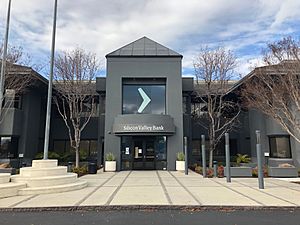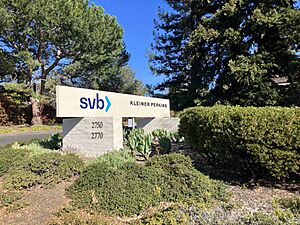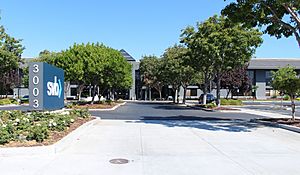Silicon Valley Bank facts for kids

Headquarters in Santa Clara
|
|
| Division | |
| Industry | Financial services |
| Fate | Failed after a bank run on its deposits, held in receivership by the FDIC, assets acquired by First Citizens Bank |
| Successors |
|
| Founded | October 17, 1983 |
| Founders |
|
| Headquarters |
,
U.S.
|
|
Key people
|
|
|
Number of employees
|
8,553 (December 2022) |
| Parent |
|
| Capital ratio | Tier 1 15.26% (2022) |
Silicon Valley Bank (SVB) is a commercial bank that is now part of First Citizens BancShares. It used to be the main part of SVB Financial Group, a company that had offices in many U.S. states and other countries.
SVB was a special bank in the San Francisco Bay Area. It focused on helping startup companies in the technology industry. It became the biggest bank for deposits in Silicon Valley. Almost half of all new tech companies that got money from investors chose SVB as their bank.
In March 2023, the bank faced a big problem. Many customers quickly tried to take out their money. This is called a bank run. This happened after interest rates went up. The bank then collapsed and was taken over by the California Department of Financial Protection and Innovation (DFPI). The DFPI said the bank didn't have enough money and was unable to pay its debts. The Federal Deposit Insurance Corporation (FDIC) then took control. This was the second-largest bank failure in U.S. history at that time.
To protect customers, the U.S. government announced that all depositors at SVB would get their money back. This included both insured and uninsured deposits. The FDIC then created a new temporary bank called Silicon Valley Bridge Bank, N.A. This new bank quickly took over SVB's business. On March 27, 2023, First Citizens Bank bought most of Silicon Valley Bridge Bank's deposits and loans from the FDIC. SVB branches then started operating as part of First Citizens Bank.
Contents
How Silicon Valley Bank Started and Grew
Starting a Bank for Startups
Silicon Valley Bank was created in 1983. It was founded by Bill Biggerstaff and Robert Medearis. They wanted to build a bank that understood the special needs of new startup companies. Roger V. Smith became the bank's first CEO. The bank officially opened on October 17, 1983. It was a part of a larger company called Silicon Valley Bancshares (now SVB Financial Group).
When SVB started, most banks didn't really understand startup companies. These new companies often didn't make money right away. SVB designed its loans to fit this. They understood that startups needed time to grow. The bank also connected its customers with many important people. This included venture capital firms, law firms, and accounting firms.
Helping Companies Grow
SVB's main plan was to collect money from businesses that got funding from venture capitalists. Then, it started offering services to venture capitalists themselves. This helped the bank keep clients as they grew from small startups into bigger companies.
At first, startup founders who wanted loans had to promise a lot of their company shares as security. But this changed over time. It became common for venture capital firms to require startups to open an account at Silicon Valley Bank. SVB preferred to work with startups that received money from top venture capital firms. This helped the bank reduce its own risks.
Early Success and Challenges
In the 1980s, the bank grew along with the high-tech industry. It made a profit for 21 quarters in a row. In 1986, SVB bought another bank called National InterCity Bank. In 1990, it opened its first office on the East Coast, near Boston. This helped it serve tech companies there.
However, in the early 1990s, the bank also got involved in real estate loans. This was a risky move. When the California real estate market slowed down, the bank lost money in 1992. By 1995, it had reduced its real estate loans. In 1993, John C. Dean became the new CEO. The bank also started a business lending money to wineries in 1994.
Expanding Across the Country and World

Growth During the Dot-Com Era
The rise of computer technology startups during the dot-com bubble brought a lot of business to SVB. The bank was known for being willing to lend money to new companies that weren't making a profit yet. By 1995, it had about 2,000 clients. These included big names like Cisco Systems. That year, the bank moved its main office from San Jose to Santa Clara.
When the dot-com bubble burst, the bank's stock price dropped. But SVB continued to open new branches in technology centers across the U.S. Ken Wilcox became CEO in 2000. He decided to keep the bank focused on technology companies.
Going International
In 2002, SVB officially started offering private banking services. This built on its existing relationships with wealthy investors and entrepreneurs. In 2003, the bank led important trips to places like Bangalore, Mumbai, Tel Aviv, Shanghai, and Beijing. They brought Silicon Valley investors to meet local business people and government officials. This was a step towards opening international offices.
In 2004, SVB announced a big international expansion. They opened new operations in Bangalore (India), London (UK), Beijing (China), and Israel.
During the 2008 Financial Crisis
During the 2008 financial crisis, SVB Financial Group received money from the U.S. government. This was part of a program to help banks. Over two years, the bank paid back the government. Greg Becker became CEO in April 2011.
In 2012, SVB partnered with a Chinese bank to create SPD Silicon Valley Bank in Shanghai. This new bank helped local technology startups. It was one of the few American-owned banks allowed to operate in Chinese currency.
By 2015, SVB said it served 65% of all U.S. startups. It also started working with virtual currency startups. In 2016, SVB helped launch Stripe's Atlas platform. This platform helps startups register as U.S. companies.
How Silicon Valley Bank Operated Before Its Collapse
Business Focus
SVB mainly served businesses and people in the technology, life science, healthcare, private equity, venture capital, and premium wine industries. The bank focused heavily on new companies backed by venture capital. It was also important for startups in India.
In December 2022, more than half of the bank's loans went to venture capital firms and private equity firms. These loans helped them invest in private companies. About 14% of its loans were mortgages for wealthy individuals. Another 24% of loans went to technology and healthcare companies. SVB often required businesses borrowing from them to have an exclusive banking relationship.
In February 2023, Forbes magazine listed SVB as one of "America's Best Banks." As of March 2023, the bank's loans were seen as safe and performing well.
Bank Locations and Offices

The bank was mainly run from its headquarters in Santa Clara, California. It also had an office in Tempe, Arizona. SVB's parent company, SVB Financial Group, had other businesses. These offered investment banking and private banking services. They had offices in Canada, the Cayman Islands, China, Hong Kong, India, Ireland, Israel, Sweden, Denmark, Germany, and the United Kingdom.
The bank's main office in Santa Clara was a large building. It was part of a group of seven office buildings. The bank also had 17 other branch locations in California and Massachusetts. The larger SVB Financial Group had a total of 55 offices across the U.S.
Community Connections
Silicon Valley Bank was a member of the Federal Reserve System. The bank's CEO was on the board of directors for the Federal Reserve Bank of San Francisco. It was also part of several industry groups.
In 1995, the bank started the Silicon Valley Bank Foundation. This nonprofit group managed the bank's community programs. The bank also sponsored a women's professional cycling team, EF Education–Tibco–SVB, starting in 2007.
Since 2002, the bank provided over $2 billion in loans and investments. This money helped build affordable housing in Silicon Valley and San Francisco, as well as in Massachusetts. It also offered free banking services to many nonprofit groups in San Mateo County, California.
The Collapse of Silicon Valley Bank
What Led to the Collapse
In 2022, SVB started losing a lot of money. This was because interest rates went up. Also, the tech industry was slowing down. The bank had invested heavily in long-term U.S. government bonds. By December 31, 2022, these investments had lost over $15 billion in value.
In early March 2023, several things caused the bank to collapse. These included poor risk management and a fast bank run. Many tech investors quickly pulled their money out. The use of social media also played a role. People affected by the possible loss of their money used social media to ask regulators for help.
Government Steps In
On March 10, 2023, officials from the Federal Reserve and the FDIC checked SVB's finances. Hours later, the California Department of Financial Protection and Innovation (DFPI) took control of SVB. They said the bank didn't have enough money and was unable to pay its debts. The FDIC was then appointed to manage the bank. The FDIC created a temporary bank called the Deposit Insurance National Bank of Santa Clara. This was to make sure customers could get their insured money the following Monday.
On March 13, 2023, the FDIC announced that SVB's assets were moved to a new temporary bank. This bank was called Silicon Valley Bridge Bank, N.A. Tim Mayopoulos was appointed as its CEO. All SVB customers became customers of this new bank. The FDIC's goal was to protect customers and keep banking services running normally. They made it clear that they were not protecting SVB shareholders.
Aftermath and New Ownership
In December 2022, it was estimated that over 85% of SVB's deposits were not insured. SVB's failure was the largest bank failure since the 2008 financial crisis. It was also the second-largest in U.S. history.
SVB's joint venture in China said their operations were "sound." The UK government worked to help British tech companies affected by the collapse of SVB's UK branch. On March 13, 2023, HSBC UK agreed to buy Silicon Valley Bank UK for a very small amount of money. This deal protected depositors and cost taxpayers nothing.
On March 17, 2023, SVB Financial Group, the former parent company, filed for Chapter 11 bankruptcy. This bankruptcy did not include its other businesses, SVB Capital and SVB Securities. Silicon Valley Bridge Bank was also not part of this filing.
A report from the Federal Reserve later said that the bank's collapse showed "weaknesses in regulation and supervision." It also suggested possible changes to how banks are regulated.
On March 26, 2023, the FDIC announced that First Citizens BancShares would buy SVB's commercial banking business. First Citizens bought about $119 billion in deposits and $72 billion of SVB's loans. SVB's 17 branches reopened the next day as "Silicon Valley Bank, a division of First Citizens Bank." All SVB depositors became customers of First Citizens. This acquisition helped First Citizens become one of the top 20 largest banks in the United States.
See also
 In Spanish: Silicon Valley Bank para niños
In Spanish: Silicon Valley Bank para niños


